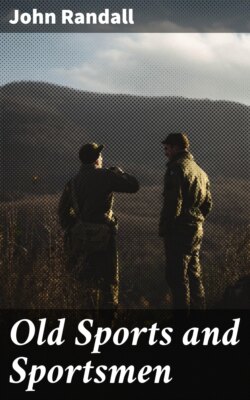Old Sports and Sportsmen

Реклама. ООО «ЛитРес», ИНН: 7719571260.
Оглавление
John Randall. Old Sports and Sportsmen
Old Sports and Sportsmen
Table of Contents
PREFACE
INTRODUCTION
CHAPTER I. THE MARSH AND FOREST PERIODS
CHAPTER II. MORFE FOREST
CHAPTER III. ROYAL CHASE OF SHIRLOT
CHAPTER IV. THE WREKIN FOREST AND THE FORESTERS
CHAPTER V. WILLEY
CHAPTER VI. THE WILLEY SQUIRE
CHAPTER VII. THE WILLEY KENNELS
CHAPTER VIII. THE WILLEY LONG RUNS
CHAPTER IX. BACHELOR’S HALL
CHAPTER X. THE WILLEY RECTOR, AND OTHER OF THE SQUIRE’S FRIENDS
CHAPTER, XI. THE WILLEY WHIPPER-IN
CHAPTER XII. SUCCESS OF THE SONG
CHAPTER XIII. THE WILLEY SQUIRE MEMBER FOR WENLOCK
CHAPTER XIV. THE SQUIRE AND HIS VOLUNTEERS
CHAPTER XV. THE WILLEY SQUIRE AMONG HIS NEIGHBOURS
THE SQUIRE’S CHESTNUT MARE
APPENDIX
A.—Page10
B.—Page41
C—Page49
D.—Page66
E.—Pedigree of the Forester Family, Page69
INDEX
ADVERTISEMENTS
Footnote
Отрывок из книги
John Randall
Published by Good Press, 2021
.....
Large sums were lavished by kings and nobles on the kennels and appliances necessary for their diversions. Nor were these costly establishments confined to the laity. Bishops, abbots, and high dignitaries of the Church, could match their hounds and hawks against those of the nobles, and they equally prided themselves upon their skill in woodcraft.
That the clergy were as much in favour of these amusements as the laity, appears from an old Shropshire author, Piers Plowman (Langland), who satirically gave it as his opinion that they thought more of sport than of their flocks, excepting at shearing time; and likewise from Chaucer, who says, “in hunting and riding they are more skilled than in divinity.” That Richard de Castillon, an early rector of Madeley, was a sportsman appears from the fact that when Henry III. was in Shrewsbury in September, 1267, concluding a treaty with Llewellyn, and settling sundry little differences with the monks and burgesses there, he granted him license to hunt “in the royal forest of Madeley,” then a portion of that of the Wrekin. In 1283 also, King Edward permitted the Prior of Wenlock to have a park at Madeley, to fence out a portion of the forest, and to form a haia there for his deer. It has been said that Walter, Bishop of Rochester, was so fond of sport, that at the age of fourscore he made hunting his sole employment. The Archdeacon of Richmond, at his initiation to the Priory of Bridlington, is reported to have been attended by ninety-seven horses, twenty-one dogs, and three hawks. Walter de Suffield, Bishop of Norwich, bequeathed by will his pack of hounds to the king; but the Abbot of Tavistock, who had also a pack, was commanded by his bishop about the same time to break it up. A famous hunter was the Abbot of Leicester, whose skill in the sport of hare hunting was so great, that we are told the king himself, his son Edward, and certain noblemen, paid him an annual pension that they might hunt with him. Bishop Latimer said: “In my time my poor father was as diligent to teach me to shoot as to learn me any other thing, and so I think other men did their children. He taught me how to draw, how to lay my body in my bow, and not draw with strength of arms as other nations do;” and the good bishop exclaims with the enthusiasm of a patriot, “It is a gift of God that He hath given us to excel all other nations withal; it hath been God’s instrument whereby He hath given us many victories over our enemies.”
.....